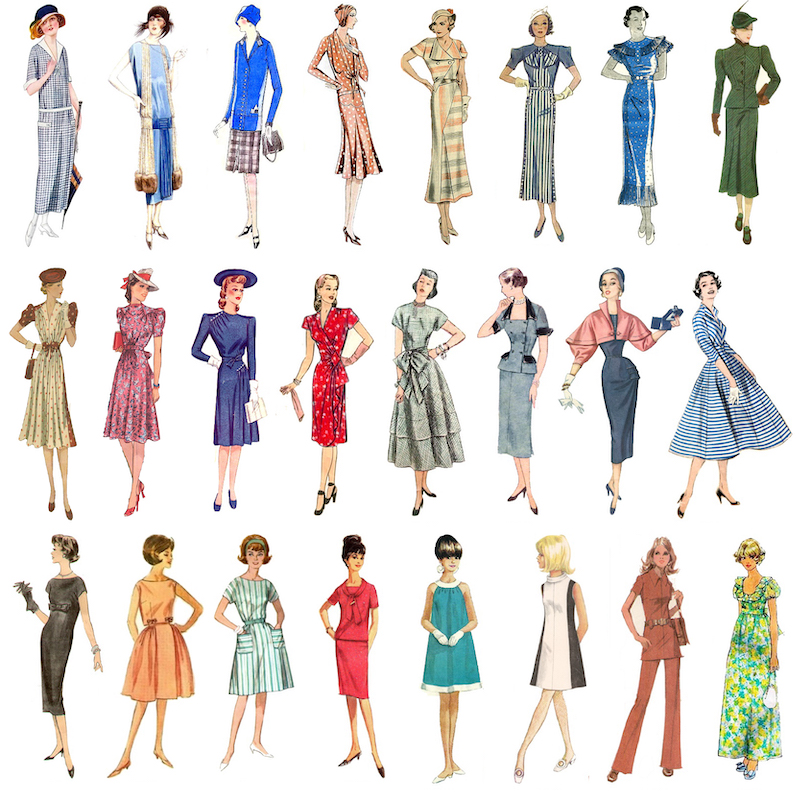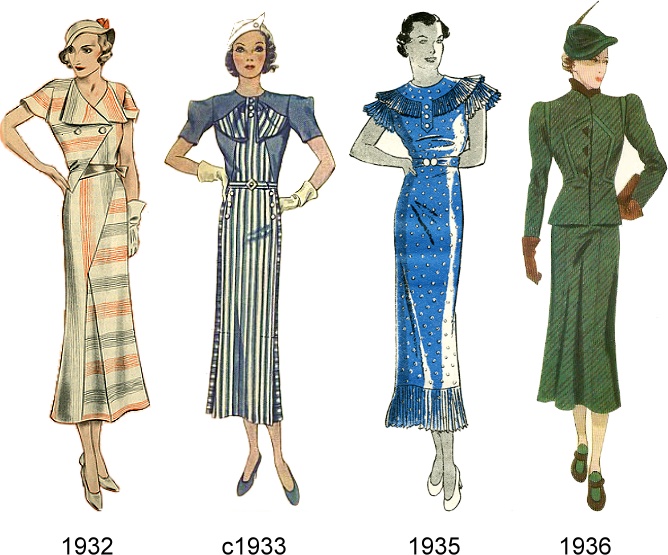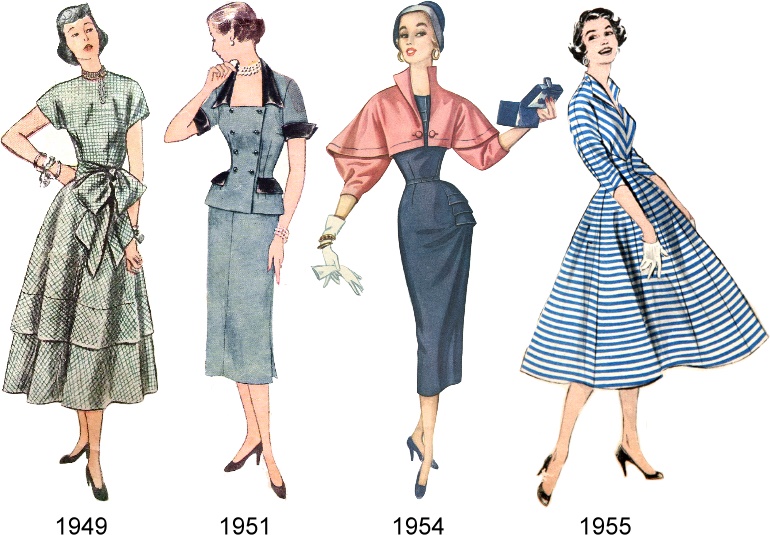One from the archives! I first published this post back in 2011, and it proved one of my most popular reference posts, and my most pinned/reposted images and content. My original aim was to provide a quick-reference guide to the key features of 20th century fashion eras to illustrate the evolution of style through the years, and to encourage a system of categorisation thinking outside the decade-by-decade box. Categorising by decade has never sat right with me - just about every decade in the 20th century saw major style changes and innovations: a frock from 1941 could hardly be more different from a Dior-influenced late 40s number, and an early 60s dress is poles apart from a 1968 mini or tunic-and-flares ensemble. Even the fifties, so closely associated with the hourglass shape, had already started moving away from Dior's 1947 New Look and towards boxier 60s styles by the latter years of the decade (Dior launched dropwaist styles as early as 1954). So I propose to classify eras based on defining styles and trends. I’m focusing here on post-1920 as clothing earlier than that is generally considered historical rather than vintage fashion.
Flapper c1923-1929
Flapper is a general classification since not everyone during the twenties was a flapper, but all fashion during this period was certainly influenced by the movement. The waistline had been gradually becoming less defined over the late teens to early 20s, and by 1923 had made its exit, with a lean silhouette and clean lines echoing the Art Deco movement. Fabrics were all about drape, flow and movement. Uneven "handkerchief" hems (where the hem falls into points), and skirt godets (as seen in the 1929 dress above) were popular; cocktail- and eveningwear often featured beading and fringe. Hemlines were rising higher than ever before, hitting knee-length by 1926. In keeping with the sleeker, streamlined silhouette, hair was bobbed and the cloche hat was in its heyday. Around 1929 the waistline began to re-emerge, but was not accentuated - often shaping would be achieved through little more than some gentle ruching at the waist.
Old Hollywood early-mid 30s
Waistlines regained some definition from around 1930. Through most of the decade the silhouette remained long and lean, with hemlines around mid-calf. This is the era of liquid satin bias-cut gowns and floaty florals exemplified by the stars of old Hollywood and the wardrobe department of television adaptations of Agatha Christie's Poirot. Art Deco influences are seen, especially in larger buttons and inventive seaming of bias dresses. Popular detailing during this period included puffed, flutter or frilly layered sleeves, and neckline interest in the form of bows, jabots and outsize collars.
Swing / WW2 Era - late 30s - c1946
There was quite a rapid style shift between 1937 and 1939 as the long, lean silhouette transitioned into the 1940s swing look. Elegant gathers and shirring replaced the ruffles and frills of the early 30s; rayon fabrics showed off the ruched and draped details. Although kimono sleeve styles were not unheard of, sleeves were generally set-in; puffed shoulders and understated leg-o-mutton sleeves in the early war years developed into square, padded shoulders, as “man-tailoring” influenced fashion trends. Skirts were flared and swingy in the late 30s and early 40s, but narrowed to a slim A-line by 1946 due to fabric rationing and “utility” guidelines. Hemlines once again rose over the same period to around knee level.
New Look 1947 - 1957
You don't need a diploma in vintage fashion to know that in 1947 Christian Dior launched his "New Look", the ultra-feminine antidote to wartime austerity, which revolutionised the way women dressed. In defiance of cloth rationing (which was still in effect in Britain until 1949) ladies adopted mid-calf length, full skirts. Gone, too, were the the masculine, square-shouldered styles of the war years; femininity was reinforced (influenced by the international drive to draw women back into the home?): the fashionable silhouette gained slightly sloping shoulders: dolman, raglan, cap and smoothly set-in sleeve styles dominated. The waist was nipped in for an exaggerated hourglass figure, assisted by structural underpinnings and cinchers. The 1950s look avoided any sartorial "middle of the road"-ness, so skirts were either bodaciously full or pencil slim; collars were either demure Peter Pan or dramatically popped wingtips; hats were close-fitting Juliet caps and cloches, or extravagant platters.
Mad Men Era late 50s - early 60s
Although nipped-in waists continued to be popular, the late 50s saw the rise of a looser-fitting silhouette, defined in boxy jackets, straight skirts and swing coats. When skirts were fuller they tended to be gathered or A-line rather than cut on the circle. Detailing was generally unfussy, although girlish flourishes such as frills and bows were also popular. High, boat and 'jewel' necklines were popular, with short or elbow-length sleeves. Hair was worn mid length, either big and bouffant (Jackie O) or in a beehive updo.
Mod, Hippie, Boho late 60s - 1970s
Mod is the shortest of my fashion eras, but no less iconic for it. The miniskirt, A-line shift dresses and bold monochromatic or colourful psychedelic prints defined the fashion world. Almost as soon as it had begun, Mod started to give way to Hippie styles, which in turn morphed into soft, Bohemian and Victorian revival fashions.















